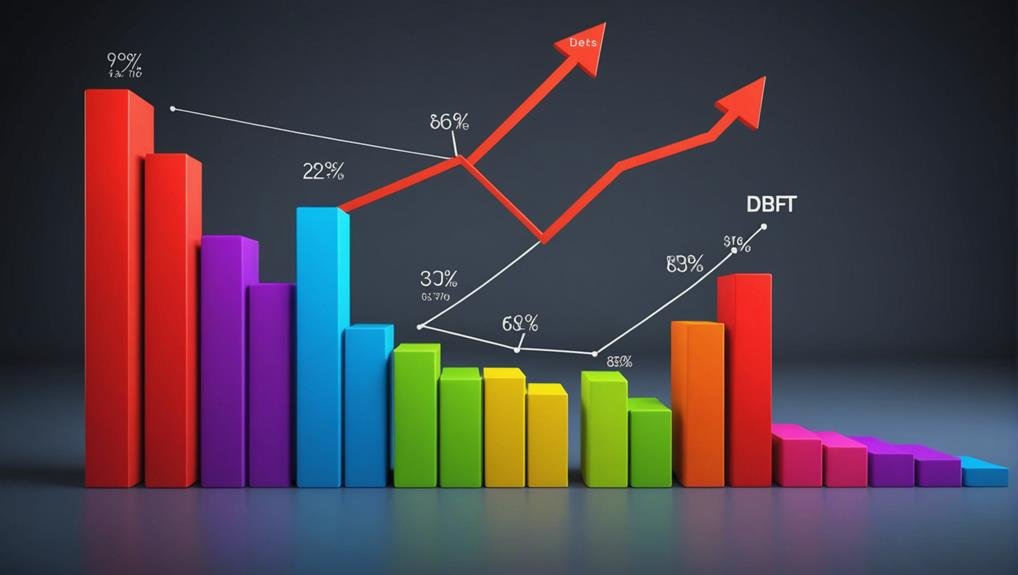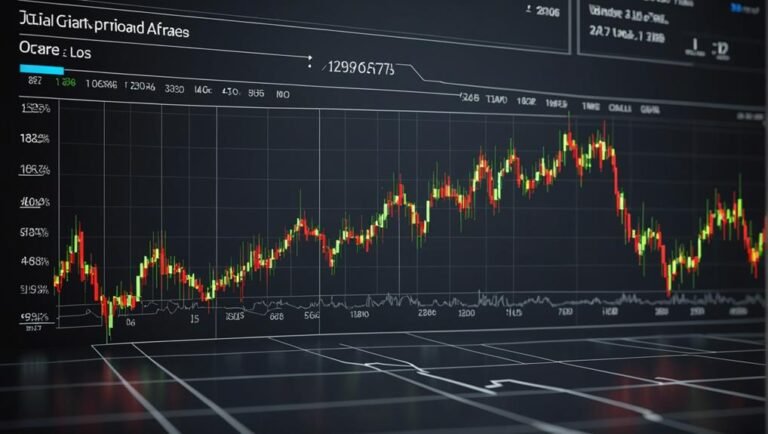Debt-to-GDP Ratio: Formula and What It Can Tell You
The debt-to-GDP ratio formula is an important indicator of a country's financial health, showing the proportion of its debt compared to the size of its economy. It helps analyze economic stability, default risks, and overall financial well-being over time. High ratios can signal potential default and instability, impacting a government's ability to repay debts. Effective strategies are essential for maintaining stability. Understanding this ratio is significant for policymakers and can influence global financial markets. To grasp its full implications and applications, consider its role in creditworthiness assessment and its significance in evaluating risks and sustainability.
Key Takeaways
- Debt-to-GDP ratio formula: Debt divided by GDP, multiplied by 100.
- Indicates country's financial health and debt sustainability.
- Reflects risks of default, financial instability, and economic growth hindrance.
- Guides policymakers on debt management strategies.
- Crucial for creditors assessing creditworthiness and global financial markets.
Understanding Debt-to-GDP Ratio
Analyzing the Debt-to-GDP Ratio provides a significant insight into a country's financial health and its ability to manage public debt in relation to its economic output. This ratio is vital in evaluating economic stability and trends over time.
A high Debt-to-GDP Ratio indicates higher risks such as potential default and financial instability. It implies that a country may struggle to pay off its debts, leading to policy implications like higher interest rates demanded by creditors. Governments with high ratios may face difficulties in borrowing, hindering growth.
Additionally, a World Bank study suggests a slowdown in economic growth for countries with elevated ratios. Understanding these risks associated with high Debt-to-GDP Ratios is essential for policymakers to implement effective strategies to maintain financial stability.
Implications of High Ratios
High Debt-to-GDP Ratios can have profound implications on a country's financial stability and economic growth prospects.
- Economic stability is jeopardized due to higher risks of default and financial panic.
- Global financial impact is significant as high ratios may deter creditors from lending.
- Countries with high ratios may face challenges in paying off external debts, triggering financial instability.
- Higher ratios can lead to increased default risk, impacting a nation's ability to borrow at favorable rates and hindering economic growth.
Factors Affecting Creditors' Decisions
Creditors' decisions on lending to a country are influenced by a combination of economic indicators, political stability, and historical repayment patterns. From a creditors' perspective, thorough risk assessment is crucial before extending credit to a nation. Factors such as the debt-to-GDP ratio, tax-to-GDP ratio, and political stability play a significant role in determining the creditworthiness of a country. Creditors assess these indicators to evaluate the potential risks associated with lending, aiming to minimize the chances of default. Historical repayment patterns also provide valuable insights into a country's commitment to honoring its financial obligations. By considering these factors, creditors can make informed decisions that align with their risk tolerance levels and overall lending strategies.
| Factors Affecting Creditors' Decisions | Importance | Impact on Credit Risk |
|---|---|---|
| Debt-to-GDP Ratio | High | Higher ratio indicates higher default risk |
| Tax-to-GDP Ratio | Medium | Higher tax burden enhances creditworthiness |
| Political Stability | High | Stable governments reduce credit risk |
Practical Applications and Insights
An in-depth analysis of the practical applications and insights surrounding the debt-to-GDP ratio reveals critical implications for economic stability and fiscal policy decisions.
Key Insights:
- Economic Stability: Understanding the debt-to-GDP ratio is vital for evaluating a country's economic stability and its ability to manage debt levels effectively.
- Policy Implications: This ratio informs policymakers on the sustainability of government debt and guides decisions on fiscal policies to maintain a healthy economic environment.
- Global Financial Impacts: The debt-to-GDP ratio influences global financial markets, affecting investor confidence and international borrowing costs.
- Risk Analysis: It serves as a key metric for risk analysis, helping identify countries at higher risk of default and financial crises.
Comparing Debt-to-GDP Ratios
The comparison of debt-to-GDP ratios across different countries provides valuable insights into their respective economic structures and fiscal health. Global comparisons reveal significant disparities, with Japan (261.3%), Greece (177.4%), and the U.S. (121.4%) standing out as the countries with the highest ratios.
Historical trends show fluctuations in these ratios over time, influenced by factors such as economic growth, government policies, and external shocks. Analyzing these variations can offer essential lessons for policymakers and investors regarding the sustainability of debt levels and potential risks of default.
Understanding the implications of these ratios on a global scale can aid in predicting economic stability, evaluating creditworthiness, and implementing effective fiscal strategies for long-term growth.
Conclusion
To sum up, the Debt-to-GDP ratio serves as a vital indicator of a country's financial stability and creditworthiness. High ratios can signal potential risks of default and economic instability, impacting interest rates and creditors' willingness to lend.
By analyzing this ratio, stakeholders can gain valuable insights into a nation's fiscal health and make informed decisions. Understanding the Debt-to-GDP ratio is not just important, but absolutely essential for maneuvering the complex world of economics.







